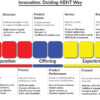
Hypercompetition has surged to the forefront of the business narrative, embodying the intense and ever-changing dynamics of today’s marketplaces. This concept, marked by swift and profound market transformations, has fundamentally altered the bedrock of traditional business strategy. It signals a monumental shift in the operational, innovative, and competitive paradigms of companies across industries. In the face of hypercompetition, businesses are compelled to rethink their approaches, pushing the boundaries of innovation and redefining the competitive landscape. This relentless market force challenges organizations to adapt at unprecedented speeds, ensuring that agility and foresight become indispensable components of their strategic arsenals.
The Hypercompetitive Arena
Hypercompetition transforms the business landscape into a battleground where the pace of change is not just fast but dizzying. In this arena, traditional industry boundaries are not just blurred but often rendered obsolete, as companies face challenges from the most unexpected quarters. This relentless environment is fuelled by a mix of disruptive innovation, the speed of market evolution, the decline of bureaucratic structures, and a shift towards what can be described as a chaotic or postmodern business paradigm.
Historical Context and Examples
The saga of the late 1990s battle between Gateway and Dell is a textbook example of hypercompetition in action. Gateway’s strategic pivot to emulate Dell’s direct-sales model was a landmark acknowledgment of the changing competitive dynamics within the PC industry. Similarly, Tesla Motors shook the automotive world with its direct-sales approach and all-electric vehicles, challenging entrenched industry norms and signalling the disruptive potential of newcomers. Moreover, Google’s venture into driverless automotive technology epitomizes the convergence of distinct sectors, heralding a new frontier of competition.
The emergence of innovative business models, such as the “freemium” approaches adopted by LinkedIn, Dropbox, Spotify, and NYTimes.com, illustrates a creative response to the hypercompetitive challenge. Amazon’s triumph in securing a $600 million data centre contract from the CIA, outmanoeuvring established tech giants, underscores the unpredictable nature of competitive threats in the digital era.
The Impact of Hypercompetition on Organizations
The relentless pressure of hypercompetition forces companies to fundamentally reassess their strategies, operational structures, and overall organizational designs. Dell’s decline, precipitated by service quality issues and the competitive onslaught from rivals like Lenovo, serves as a vivid reminder of the unforgiving nature of hypercompetitive markets. Companies must navigate shifting consumer preferences, technological breakthroughs, and global market dynamics with unprecedented agility and foresight.
Organizational Responses to Hypercompetition
The transformation of Delphi Corporation, from traditional assembly lines to modular workstations organized in small cells, exemplifies an organizational adaptation to the pressures of hypercompetition. This strategic realignment was aimed at enhancing flexibility, speed, and customization to meet automaker demands. Despite these efforts, Delphi’s bankruptcy filing in 2006 starkly illustrates the intense challenges companies face in maintaining competitiveness in such volatile environments.
The Imperative for Continuous Adaptation
Hypercompetition marks a significant transformation in the competitive landscape, diminishing the relevance of traditional industry boundaries and exposing companies to threats from unconventional competitors. The experiences of Gateway, Tesla, and Delphi illuminate the spectrum of responses to these pressures, ranging from structural reorganizations to the inception of groundbreaking business models. However, Delphi’s failure serves as a cautionary tale, highlighting that even substantial organizational changes may fall short in the relentless tide of hypercompetition.
In this ever-changing business environment, success hinges on continuous innovation, adaptability, and strategic agility. Companies must perpetually reassess their strategies and remain vigilant, ready to pivot in response to the shifting winds of market dynamics, technological advancements, and emerging competitive threats. The journey through the hypercompetitive landscape is fraught with challenges, but it also offers opportunities for those organizations that can harness the power of change to forge new paths to success. This dynamic era demands more than mere survival; it calls for a relentless pursuit of excellence and innovation to thrive in the whirlwind of modern business.
Prof. Dr. Prahlada N. B
13 February 2024
Chitradurga.

















Leave a reply